| 1 |
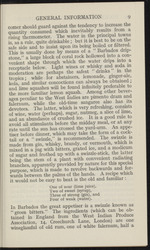 |
“...preferable to
the more familiar lemon squash. Among other bever-
ages peculiar to the West Indies are pimento dram and
falemum, while the old-time sangaree also has its
devotees. The latter, which is very refreshing, consists
of wine, water (perhaps), sugar, nutmeg, a slice of lime,
and an abundance of crushed ice. It is a good rule to
avoid all stimulants before the midday meal, or at any
rate until the sun has crossed the yard-arm. An appe-
tiser before dinner, which may take the form of a cock-
tail or a “ swizzle,” is recommended. The swizzle is
made from gin, whisky, brandy, or vermouth, winch is
mixed in a jug with bitters, grated ice, and a modicum
of sugar and frothed up with a swizzle-stick, the latter
being the stem of a plant with convenient radiating
branches, apparently provided by nature for this special
purpose, which is made to revolve backwards and for-
wards between the palms of the hands. A recipe which
it would not be easy to beat is the old and familiar:
One of sour (lime...”
|
|
| 2 |
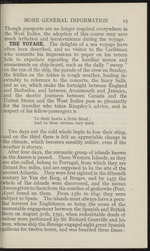 |
“...MORE GENERAL INFORMATION
19
I Though passports are no longer required everywhere in
I the West Indies, the adoption of this course may save
much irritation and inconvenience during the voyage.
THE VOYAGE. The delights of a sea voyage have
I often been described, and no visitor to the Caribbean
■who commits his impressions to paper on his return
■ fail? to expatiate regarding the familiar scenes and
■amusements on ship-board, such as the daily “ sweep ”
Ion the run of the ship, the parade of the crew on Sunday,
■ the fiddles on the tables in rough weather, leading in-
ievitably to reference to the concerts, the fancy balls,
land so on, which make the fortnight between England
land Barbados, and between Avonmouth and Jamaica,
land the shorter journeys between Canada and the
■United States and the West Indies pass so pleasantly
! for the traveller who takes Kingsley’s advice, and in
■respect of his fellow:passengers is
"To their faults a little blind ;
And to their virtues very kind.
I, Two...”
|
|
| 3 |
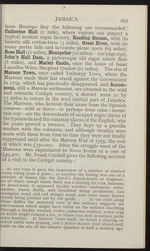 |
“...to the Cockpit country:
At one time it gave the impression of a number of stunted
imahoe Santa Maria, and broadleaf being promimmt, and
■mosquito wood and red shingle wood, and other lesser known
P°mted out by our guide-----As one rides along
Ithese defiles the mournful note of the solitaire suggests thl
nervousness which might have fallen on the soldiers marching
Khrough a thickly wooded, rocky, unknown country, every crag
iDf which might conceal a foe, to whose foot such mountain path!
were familiar. At Maroon Town itself, we found a clearing on
SlCal!e Wfe ?r?flnghand a P°lice station (just abandoned)
ibudt on the site of the officers’ quarters of half a century ago...”
|
|
| 4 |
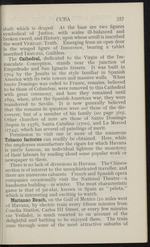 |
“...base are two figures
(symbolical of Justice, with scales ln-balancedjmd
symbolical of Justice, with scales Ui-oaiancea ana
j broken sword, and History, upon whose scroll is inscribed
the word Verdad; Truth. Emerging from an open door
is the winged figure of Innocence, bearing a tablet
'inscribed Immunis, Guiltless.
The Cathedral, dedicated to the Virgin of the Im-
maculate Conception, stands near the junction of
Empedrado and San Ignacio Streets. It was built in
1704 by the Jesuits in the style familiar in Spanish
America with its twin towers and massive walls. When
; Santo Domingo was ceded to France, remains, believed
to be those of Columbus, were removed to this Cathedral
with great ceremony, and here they remained until
11809, when, after the Spanish-American war, they were
[transferred to -Seville. It is now generally believed
that the remains in question were not those of the dis-
coverer, but of a member of his family (see page 369).
1 Other churches of note are those of Santo Domingo...”
|
|
| 5 |
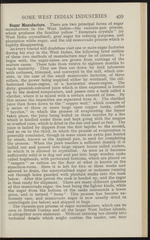 |
“...SOME WEST INDIAN INDUSTRIES 439
Sugar Manufacture. There are two principal forms of sugar
manufacture in the West Indies—the vacuum-pan process,
which produces the familiar yellow “ Demerara crystals (or
West India crystallised), grey sugar for refining purposes, and
plantation white sugar, and the old muscovado process which is
rapidly disappearing. ' . .
As every tourist will doubtless visit one or more sugar factories
during his stay in the West Indies, the following brief outline
of these two methods of manufacture may be of interest. To
begin with, the sugar-canes are grown from cuttings of the
mature canes. These take from twelve to eighteen months to
reach maturity. They are then cut down by field labourers
with cutlasses, trimmed, and conveyed to the mill, which con-
sists, in the case of the small muscovado factories, of three
rollers, the power being supplied either by windmall, the old-
fashioned beam-engine, or a horizontal steam-engine. The
dirty, greenish-coloured juice which...”
|
|
| 6 |
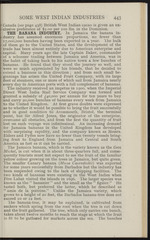 |
“...voyage was infinitesimal. An increasing demand
!for Jamaica bananas in the United Kingdom has developed
I with surprising rapidity, and the company known as Messrs.
Elders and Fyffes now have no fewer than twenty vessels bring-
ing fruit to England from Jamaica and Central and South
America as fast as it can be carried.
The Jamaica banana, which is the variety known as the Gros
Michel, is cut when it is about three-quarters full, and conse-
quently tourists must not expect to see the fruit of the familiar
yellow colour growing on the trees in Jamaica, but quite green.
The smaller Canary banana [Musa Cavendishii) was exported
for some years successfully from Barbados but the industry has
been suspended owing to the lack of shipping facilities. The
two kinds of bananas were existing in the West Indies when
Père Labat visited the islands in 1696. The larger species was
known as the “ bananier ” and the small as the “ figuier.” He
tasted both, but preferred the latter, which he described as
" amie...”
|
|
